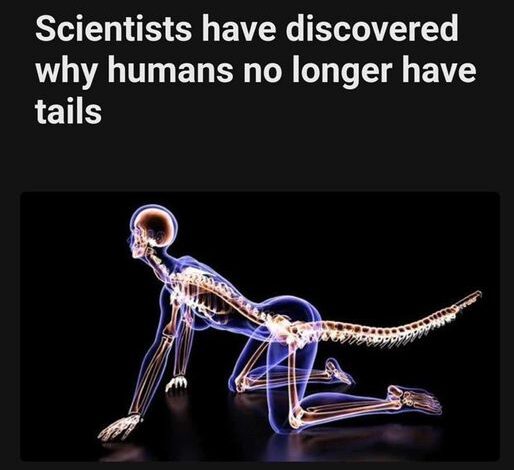
SCIENTISTS REVEAL WHY HUMANS NO LONGER HAVE TAILS
One of the most notable evolutionary changes in human history is the loss of the tail. This significant alteration appears to have occurred approximately 25 million years ago, and it represented a turning point in the evolutionary history of our species and our ape cousins.
Though there are many theories regarding why we lost our tails, the genetic causes are still unknown. The genetics behind our tails’ extinction is disclosed in a novel study that was just published in the esteemed magazine Nature.
THE LOST TAILS OF HUMANS: HOW DID WE GET HERE?
The first clue to the mystery of why humans lost their tails came from an unlikely place. After breaking his own coccyx, a graduate student at New York University named Bo Xia began to wonder where the human tailbone came from. Xia and his colleagues embarked on a scientific expedition that resulted in a remarkable discovery due to their curiosity.
Thorough research was conducted on the TBXT gene, which is important for controlling tail length in many different species. They discovered a rare DNA mutation hidden inside the gene, which led to a significant advancement in our knowledge of the evolution of humans.
The importance of jumping genes—more especially, Alu elements—in generating genetic variation and promoting evolutionary change is fundamental to this discovery. These monkey-specific Alu elements exerted their influence by enshrouding themselves in the TBXT gene, a phenomenon that has far-reaching consequences for humans. (it’s essentially the reason we lost our tails)
Alternative splicing is the outcome of a series of molecular events that were set off by the insertion of Alu elements into the TBXT gene. This process has not been previously identified in relation to tail evolution. The structure and function of the resultant protein (our tails) were changed as a result of this complex mechanism, which involves the cutting and rearranging of RNA molecules. You can probably guess which exon was lost in the process.
FROM MICE TO MEN: EXPERIMENTAL VALIDATION
The researchers genetically engineered laboratory mice to carry the same mutations seen in humans and apes in order to validate their findings. The fact that these mice lost their tails and had a strong resemblance to our tailless lineage after being altered provides strong evidence for the involvement of the discovered genetic mutation.
But the research also showed that losing one’s tail increases a person’s risk of developing neural tube problems, in our instance spina bifida. This discovery demonstrates the intricate relationship between genetic adaptations and possible evolutionary trade-offs.
WHAT COMES AFTER HUMANS LOSE THEIR TAILS?
This finding has far-reaching consequences outside of the field of evolutionary biology. Deep insights into the complexities of human anatomy and health are provided by this study. It seems that our loss of tails was a genetic adaptation with far-reaching effects rather than just a coincidental event.
The complex dance between genetic innovation and natural selection that has formed human history is brought to light when we reflect on our evolutionary past. Because of our natural curiosity and highly developed scientific minds, we are still on a mission to solve the riddles surrounding our origins.
We have therefore discovered the genetic explanation for why humans lost their tails, and this is evidence of the value of scientific research and the never-ending quest for knowledge. We should be reminded that the secrets of our history hold the key to solving the mysteries of our future, even as we celebrate the fresh discoveries made in tracing our beginnings.





